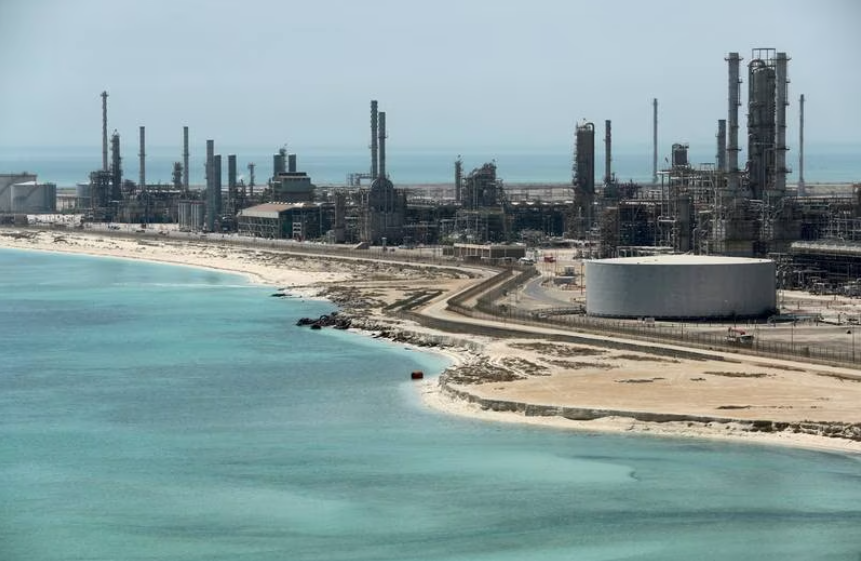
Saudi Aramco's Ras Tanura oil refinery and oil terminal. Opec+ members Saudi Arabia, the UAE, Iraq, Kuwait and Algeria have agreed to voluntary oil production cuts. Reuters
Opec+ members Saudi Arabia, the UAE, Iraq, Kuwait, Oman and Algeria will implement voluntary oil production cuts exceeding more than one million barrels per day from May until the end of the year as a precautionary measure aimed at supporting the stability of the oil market.
The group of 23 oil-producing countries, which slashed its collective output by two million barrels per day last year, was expected to stick to the agreed production levels at its upcoming meeting on Monday.
Saudi Arabia, the world’s biggest oil exporter and Opec's largest producer, will cut its output by 500,000 bpd from May until the end of the year, the UAE's Ministry of Energy said on Sunday.
The UAE will cut its output by 144,000 bpd for the same period, Suhail Al Mazrouei said.
“This voluntary initiative is a precautionary measure taken to ensure market balance and comes in alignment with the production cut agreed upon during the 33rd Opec and non-Opec Ministerial Meeting (ONOMM), held on 5th October 2022,” Mr Al Mazrouei said.
Iraq's oil ministry also announced an output cut of 211,000 barrels per day from May 1 to "stabilise the market", Barron's reported.
Kuwait and Algeria joined the voluntary oil output cuts, while Russia said the production cut it was implementing from March to June would continue until the end of the year, Bloomberg reported.
Oman has decided to reduce crude oil production by 40,000 bpd.
Goldman Sachs recently reduced its oil price forecasts for 2023, citing growing crude supplies and lower demand. The investment bank now expects Brent to trade at $94 a barrel in the coming 12 months and at $97 in the second half of 2024. It had previously projected that the benchmark would trade at $100 in both scenarios.
Oil prices closed higher on Friday, its second consecutive week of gains, as the supply disruption through a Turkish port continues to affect an already tight market.
Brent, the benchmark for two-thirds of the world’s oil, rose 1.64 per cent to settle at $79.89 a barrel on Friday. West Texas Intermediate, the gauge that tracks US crude, gained 1.75 per cent to close at $75.67 a barrel.
Brent prices rose 6.5 per cent over the previous week and WTI gained 9.3 per cent.
Despite the gain on Friday, Brent is down about seven per cent since the start of the year.
Today’s announcement follows a historic cut in October, when the 23-member alliance of oil-producing countries slashed its crude output by two million barrels per day, its biggest production cut since the start of the Covid-19 pandemic in 2020.
The decision was made in “light of the uncertainty that surrounds the global economic and oil market outlooks, and the need to enhance the long-term guidance for the oil market, and in line with the successful approach of being proactive and pre-emptive”, Opec+ said at the time.
Less than two weeks ago, Opec further raised its 2023 forecast for Chinese oil demand growth as the country gradually reopens its economy after ending nearly three years of zero-Covid regulations.
At the time, the group maintained this year's crude demand estimate at 2.3 million bpd on concerns of an economic slowdown in the US and Europe.
“We expect [oil] prices ahead to increase slightly due in large part to a rise in jet fuel demand within China and higher gasoline demand in the Western portion of the world … rising demand in the second half of 2023 will tighten the supply-demand balances,” said Ha Nguyen, executive director for global oil at S&P Global Commodity Insights.
Opec Secretary General Haitham Al Ghais said that the group is seeing a “divided market” with one segment showing signs of “promising” growth and the other experiencing a decline.
“There is phenomenal demand growth in Asia [but] what concerns us more is actually the slowdown we see in Europe and the US in terms of the financial situation [and] the inflation,” Mr Al Ghais said at the CeraWeek energy conference in Houston last month.
The International Energy Agency expects global oil demand to rise “sharply” this year on the back of pent-up Chinese demand and a rebound in air traffic.
In its latest oil market report, the agency said oil demand growth would “accelerate” to 2.6 million bpd in the fourth quarter.
While near-term oil prices are likely to remain volatile — influenced by the current financial market turmoil — Swiss bank UBS has retained a positive outlook.
It expects rising Chinese crude imports and demand, plus lower Russian production, to tighten up the oil market and lift prices over the coming quarters.
“We think fundamentals support a tightening of the oil market,” UBS strategist Giovanni Staunovo said in a research note last week.
“China's recovery is pushing Chinese crude imports higher, and the US saw a large drop in refined product inventories” in the March 20-24 week, he said.